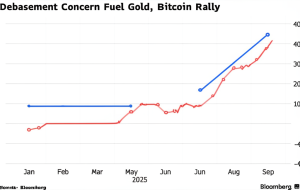
Bitcoin’s Potential Ascent to $150,000: A 2025 Forecast
Bitcoin, the pioneering cryptocurrency, has consistently defied expectations since its inception in 2009. Its volatile nature and decentralized structure have made it a focal point for investors, technologists, and economists alike. The cryptocurrency’s price has experienced dramatic swings, from its humble beginnings to its all-time highs. Among the myriad of predictions about Bitcoin’s future, one figure stands out: $150,000. This ambitious target has been floated by several analysts and investors, who believe that Bitcoin could reach this milestone by 2025. To understand the plausibility of this forecast, it is essential to examine the underlying factors that could drive Bitcoin’s price to such heights, as well as the potential obstacles that could impede its progress.
The Bullish Case: Catalysts for Growth
Several converging factors create a potentially explosive environment for Bitcoin’s price, making the $150,000 target a plausible scenario.
1. Supply Shock Dynamics:
One of the most critical factors influencing Bitcoin’s price is its supply dynamics. Bitcoin’s fixed supply cap of 21 million coins ensures that it is a deflationary asset. As the cryptocurrency gains mainstream adoption, the demand for Bitcoin is expected to increase, while its supply remains constrained. This imbalance between supply and demand could lead to a significant price appreciation.
Long-term holders, often referred to as “HODLers,” are increasingly reluctant to sell their Bitcoin, preferring to store it in cold wallets for long-term investment. This behavior reduces the available supply of Bitcoin in the market, exacerbating the supply shock. Furthermore, institutional investors and treasury firms are accumulating Bitcoin as a strategic asset, further tightening the supply.
The reduction in available supply, coupled with rising demand, could trigger a significant supply shock, propelling the price upward. Historical data supports this thesis, as periods of reduced supply have often coincided with substantial price increases.
2. Halving Impact and Historical Patterns:
Bitcoin’s halving events, which occur approximately every four years, reduce the reward for mining new blocks by 50%. This engineered scarcity has historically led to significant price increases in the following months and years. The most recent halving occurred in April 2024, and historical patterns suggest that a substantial price surge could be on the horizon, potentially peaking in late 2025.
Analysts often draw on these patterns to make predictions about Bitcoin’s future price. For instance, the 2020 halving was followed by a significant price surge, with Bitcoin reaching an all-time high of nearly $69,000 in late 2021. If history repeats itself, the 2024 halving could set the stage for a similar, if not more substantial, price appreciation.
Some analysts predict a peak between $130,000 and $150,000 by late August to early September 2025, based on these historical patterns. This prediction is supported by the fact that previous halving cycles have seen Bitcoin’s price increase significantly in the 12 to 18 months following the event.
3. Growing Institutional Adoption and ETF Inflows:
The increasing acceptance of Bitcoin by institutional investors is a game-changer for the cryptocurrency market. Institutional investors bring significant capital and credibility to the market, which can drive up the price of Bitcoin.
The launch of Bitcoin ETFs has opened the doors for traditional investors to gain exposure to Bitcoin without directly holding the asset. This influx of capital could significantly impact Bitcoin’s price. Some projections suggest that if ETF inflows reach $80 billion by the end of 2025, Bitcoin could see a price range of $120,000 to $150,000.
The approval of Bitcoin ETFs by regulatory bodies such as the U.S. Securities and Exchange Commission (SEC) has been a significant milestone for the cryptocurrency. These ETFs provide a regulated and accessible way for institutional investors to invest in Bitcoin, further legitimizing the asset class.
4. Global Liquidity and Monetary Policy:
Bitcoin’s price is often correlated with global liquidity. As central banks inject money into the financial system, the increased liquidity can flow into assets like Bitcoin. This dynamic has been particularly evident during periods of quantitative easing, when central banks have injected large amounts of liquidity into the financial system.
With rising global liquidity and strong investor sentiment, Bitcoin is well-positioned to break the $150,000 barrier. The cryptocurrency’s decentralized nature and fixed supply make it an attractive hedge against inflation and currency devaluation, further driving demand.
5. The “Trump Effect”:
While less predictable, political factors can also influence Bitcoin’s price. The potential for a “Trump effect,” stemming from specific economic policies or legislative actions, has been suggested as a catalyst for a price surge.
For instance, if the former U.S. president’s policies favor a more pro-cryptocurrency stance, it could lead to increased adoption and investment in Bitcoin. Conversely, if his policies are perceived as hostile to the cryptocurrency market, it could have the opposite effect.
Potential Roadblocks: Challenges to Overcome
While the bullish case is compelling, several factors could prevent Bitcoin from reaching $150,000 by 2025.
1. Market Corrections and Bearish Divergences:
The cryptocurrency market is known for its volatility. Technical analysis suggests that Bitcoin could face a significant correction, potentially falling by 50% or more. A bearish RSI divergence, similar to patterns observed in 2021, could signal an impending pullback, challenging the $150,000 target.
Market corrections are a natural part of any asset’s price cycle, and Bitcoin is no exception. These corrections can be triggered by various factors, including profit-taking, changes in market sentiment, or external shocks.
2. Regulatory Uncertainty and Government Action:
Increased regulatory scrutiny and potential government intervention could dampen investor enthusiasm and negatively impact Bitcoin’s price. Unfavorable regulations or outright bans in major economies could trigger a sell-off and hinder Bitcoin’s growth.
Regulatory uncertainty is a significant risk factor for Bitcoin and the broader cryptocurrency market. Governments around the world are grappling with how to regulate this new asset class, and their actions can have a substantial impact on Bitcoin’s price.
3. Black Swan Events and Unforeseen Circumstances:
Unexpected events, such as major security breaches, technological failures, or macroeconomic shocks, could disrupt the market and derail Bitcoin’s upward trajectory. These unforeseen circumstances, often referred to as “black swan” events, are difficult to predict but can have a significant impact on asset prices.
For instance, a major security breach in a prominent cryptocurrency exchange or wallet provider could erode investor confidence and lead to a sell-off. Similarly, a macroeconomic shock, such as a global recession or financial crisis, could negatively impact Bitcoin’s price.
4. Competition from Altcoins:
While Bitcoin remains the dominant cryptocurrency, the altcoin market is constantly evolving. The emergence of new and innovative projects could attract capital away from Bitcoin, limiting its potential for price appreciation.
Altcoins, or alternative cryptocurrencies, have gained significant traction in recent years. These projects often offer unique features and use cases that differentiate them from Bitcoin. As a result, they can attract capital away from Bitcoin, potentially limiting its price appreciation.
Alternative Predictions and Wider Scenarios
While $150,000 is a prominent target, other predictions offer a broader spectrum of possibilities.
- Lower Estimates: Some analysts predict a more conservative target range of $120,000 to $150,000, acknowledging the potential for market corrections and other challenges.
- Higher Estimates: More optimistic forecasts envision Bitcoin reaching significantly higher levels, with some predicting prices as high as $180,000 or even $400,000 in the coming years.
- Long-Term Projections: Looking further into the future, some predictions suggest that Bitcoin could reach unprecedented levels, with analysts forecasting $1 million by 2025.
Conclusion: A Balancing Act of Optimism and Caution
The potential for Bitcoin to reach $150,000 by 2025 is a complex equation, influenced by a confluence of factors. The tightening supply, the historical impact of halving events, growing institutional adoption, and global liquidity all contribute to a compelling bullish narrative. However, potential roadblocks such as market corrections, regulatory uncertainty, and unforeseen events cannot be ignored.
Ultimately, whether Bitcoin reaches $150,000 by 2025 depends on the interplay of these forces. While the potential rewards are substantial, investors should approach the market with a balanced perspective, carefully considering the risks and potential challenges that lie ahead. Bitcoin’s journey is rarely a straight line, and navigating the market requires both optimism and a healthy dose of caution. The cryptocurrency’s volatile nature and decentralized structure make it a unique and fascinating asset class, one that continues to captivate investors and analysts alike. As the market evolves, so too will the predictions and forecasts about Bitcoin’s future price.




